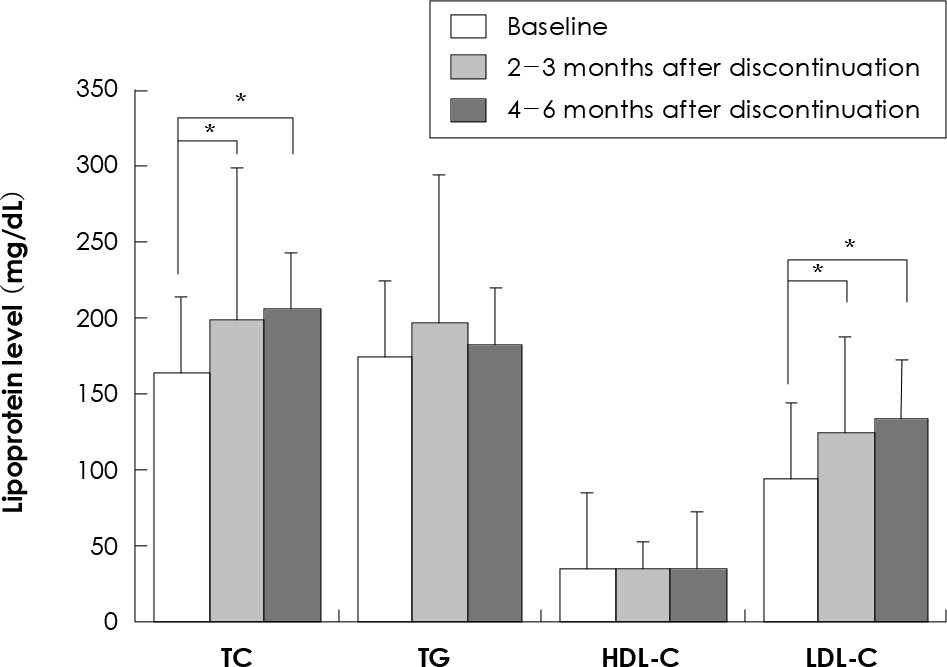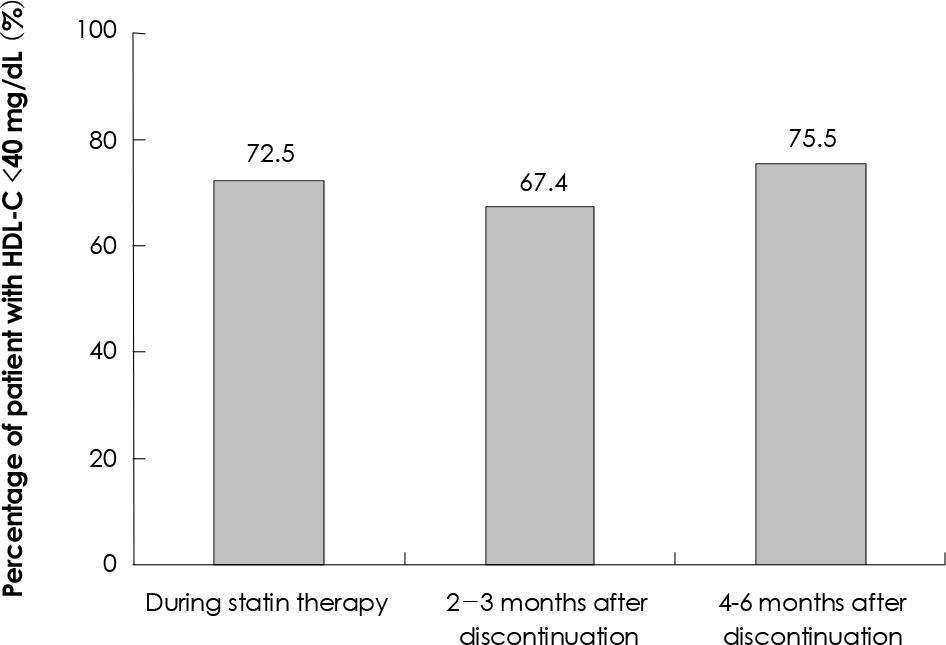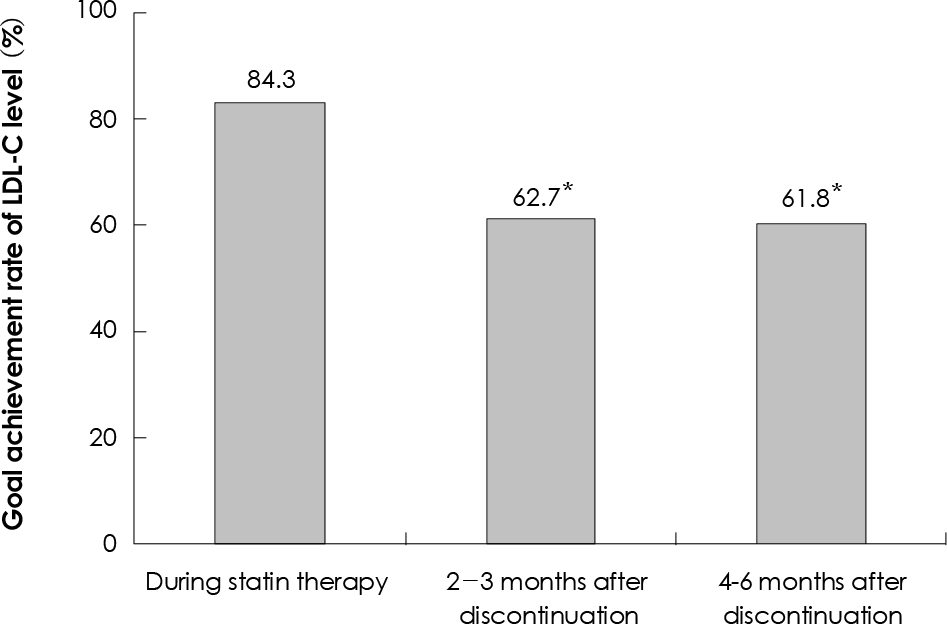Abstract
Background and Objectives
Some patients stop statin therapy in spite of their doctors' advice. This study was designed to assess the pattern of lipoprotein profile changes and clinical characteristics of the patients who discontinued statin therapy.
Subjects and Methods
69 patients (male 42.0%) were enrolled. The clinical characteristics and laboratory data on the lipoprotein levels were obtained from the medical records.
Results
The coexistence of diabetes mellitus (DM) was seen in 28% of the patients, hypertension was noted in 72% and coronary artery disease (CAD) was noted in 42%. The average lipoprotein levels during statin therapy were total cholesterol (TC)= 163.8 mg/dL, triglycerides (TG)=174.3 mg/dL, high-density lipoprotein cholesterol (HDL-C)=34.8 mg/dL and low-density lipoprotein cholesterol (LDL-C)=94.2 mg/dL. LDL-C level increased by 44.9% at 2–3 months after ceasing statin therapy and by 54.6% at 4–6 months after ceasing statin therapy (p<0.01). The changes of the lipoprotein levels from baseline to 2–3 months and 4–6 months after discontinuation were +22.6% and +30.0% for the TC level, +20.8% and +24.0% for the TG level, and 0.06% and −0.65% for the HDL-C level respectively (p<0.01 for TC and TG, p=not significant (NS) for HDL-C). The achievement rate of target LDL-C level as suggested by the Adult Treatment Panel III (ATP III) of National Cholesterol Education Program (NCEP) was decreased 62.7% at 2–3 months and then it was decreased to 61.8% at 4–6 months after statin discontinuation. DM and CAD were more frequent in the patients who did not achieve the target LDL-C level even with life style modification.
Go to : 
References
1. Shepherd J, Cobe SM, Ford I, et al. Prevention of coronary heart disease with pravastatin in men with hypercholesterolemia. N Engl J Med. 1995; 333:1301–7.

2. Sever PS, Dahlof B, Poulter NR, et al. Prevention of coronary and stroke events with atorvastatin in hypertensive patients who have average or lower-than-average cholesterol concentrations, in the Anglo-Scandinavian Cardiac Outcomes Trial–Lipid Lo-weringArm (ASCOT-LLA): a multicentre randomised controll-edtrial. Lancet. 2003; 361:1149–58.
3. Downs JR, Clearfield M, Weis S, et al. Primary prevention of acute coronary events with lovastatin in men and women with average cholesterol levels. JAMA. 1998; 279:1615–22.

4. The LIPID Study Group. Prevention of cardiovascular events and death with pravastatin in patients with coronary heart disease and a broad range of initial cholesterol levels. N Engl J Med. 1998; 339:1349–57.
5. Jun JE. Cholesterol lowering therapy in coronary artery disease. Korean Circ J. 2001; 31:849–56.
6. Chun KJ, Chung NS, Ha JW, et al. Efficacy and safety of atorvastatin in patients with elevated LDL-cholesterolemia. Korean Circ J. 1999; 29:1309–16.

7. Bae JH, Choe KH, Jun JE, et al. Multicenter clinical trial of atorvastatin in patients with hypercholesterolemia. Korean Circ J. 2001; 31:434–41.

8. Grundy SM, Cleeman JI, Merz CN, et al. Implications of recent clinical trials for the National Cholesterol Education Program Adult Treatment Panel III guidelines. Circulation. 2004; 110:227–39.

9. Committee of Treatment Guideline for Hypercholesterolemia. Treatment guideline for hypercholesterolemia. 2nd ed. Korean Society of Lipidology and Atherosclerosis;2003.
10. Kim SH, Park JS, Zo JH, Kim MA, Kim HS. Treatment gap in the management of hypercholesterolemia in Korea: return on expenditure achieved for lipid therap Y (REALITY). Korean Circ J. 2006; 36:593–9.
11. Andrade SE, Walker AM, Gottlieb LK, et al. Discontinuation of antihyperlipidemic drugs: do rates reported in clinical trials reflect rates in primaty care setting? N Engl J Med. 1995; 332:1125–31.
12. Bradford RH, Shear CL, Chremos AN, et al. Expanded Clinical Evaluation of Lovastatin (EXCEL) study result: I. efficacy in modifying plasma lipoproteins and adverse event profile in 8245 patients with moderate hypercholesterolemia. Arch Intern Med. 1991; 151:43–9.
13. Ellis JJ, Erickson SR, Stevenson JG, Bernstein SJ, Stiles RA, Fendrick AM. Suboptimal statin adherence and discontinuation in primary and secondary prevention populations: should we target patients with the most to gain? J Gen Intern Med. 2004; 19:638–45.
15. Heeschen C, Hamm CW, Laufs U, Snapinn S, Bohm M, White HD. Withdrawal of statins increases event rates in patients with acute coronary syndromes. Circulation. 2002; 105:1446–52.

16. Li JJ, Li YS, Chu JM, et al. Changes of plasma inflammatory markers after withdrawal of statin therapy in patients with hyperlipidemia. Clin Chim Acta. 2006; 366:269–73.

17. Thomas M, Mann J. Increased thrombotic vascular events after change of. Lancet. 1998; 352:1830–1.
18. Heeschen C, Hamm CW, Laufs U, Snapinn S, Bohm M, White HD. Withdrawal of statins in patients with acute coronary syn-droms. Circulation. 2003; 107:e27.

19. Spencer FA, Fonarow GC, Frederick PD, et al. Early withdrawal of statin therapy in patients with non-ST-segment elevation myocardial infarction: national registry of myocardial infarction. Arch Intern Med. 2004; 164:2162–8.
20. Spencer FA, Allegrone J, Goldberg RJ, et al. Association of statin therapy with outcomes of acute coronary syndromes: the RACE study. Ann Intern Med. 2004; 140:857–66.
21. Endres M, Laufs U. Discontinuation of statin treatment in stroke patients. Stroke. 2006; 37:2640–3.

22. Colivicchi F, Bassi A, Santini M, Caltagirone C. Discontinuation of statin therapy and clinical outcome after ischemic stroke. Stroke. 2007; 38:2652–7.

23. Tristano AG, Castejon AM, Castro A, Cubeddu LX. Effect of statin treatment and withdrawal on angiotensin II-induced phosphorylation of p38 MAPK and ERK1/2 in cultured vascular smooth muscle cells. Biochem Biophys Res Commun. 2007; 353:11–7.
24. Lee KT, Lai WT, Chu CS, et al. Effect of withdrawal of statin on C-reactive protein. Cardiology. 2004; 102:166–70.

25. Laufs U, Endres M, Custodis F, et al. Suppression of endothelial nitric oxide production after withdrawal of statin treatment is mediated by negative feedback regulation of rho GTPase gene transcription. Circulation. 2000; 102:3104–10.

26. Vecchione C, Brandes RP. Withdrawal of 3-hydroxy-3-methylglutaryl coenzyme A reductase inhibitors elicits oxidative stress and induces endothelial dysfunction in mice. Circ Res. 2002; 91:173–9.

27. Brandes RP, Beer S, Ha T, Busse R. Withdrawal of cerivastatin induces monocyte chemoattractant protein 1 and tissue factor expression in cultured vascular smooth muscle cells. Arterioscler Thromb Vasc Biol. 2003; 23:1794–800.

Go to : 
 | Fig. 1.The changes of serum lipoprotein levels after statin discontinuation. ∗p<0.001. TC: total cholesterol, TG: triglycerides, HDL-C: high-density lipoprotein cholesterol, LDL-C: low-density lipoprotein cholesterol. |
 | Fig. 2.The percentages of patients whose HDL-C levels were lower than 40 mg/dL (p=NS). HDL-C: high-density lipoprotein cholesterol. |
 | Fig. 3.The achievement rate of target LDL-C level by NCEP-ATP III guideline. ∗p<0.001 when compared with goal-achievement rate during statin therapy. LDL-C: low-density lipoprotein cholesterol. NCEP-ATP III: National Cholesterol Education Program Adult Treatment Panel III. |
Table 1.
Baseline clinical characteristics of the patients
| Patients (n=69) | |
|---|---|
| Male, n (%) | 27 (42) |
| Age (years), mean±SD | 63.6±9.1 |
| BMI (kg/m2), mean±SD | 25.5±3.4 |
| Hypertension, n (%) | 46 (72) |
| Diabetes mellitus, n (%) | 19 (28) |
| Coronary artery disease, n (%) | 27 (42) |
Table 2.
The changes of lipoprotein profiles after statin discontinuation
Table 3.
Clinical characteristics comparing goal achievement group and the others, whose LDL-C level were not achieved treatment goal




 PDF
PDF ePub
ePub Citation
Citation Print
Print


 XML Download
XML Download